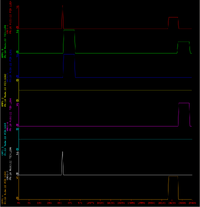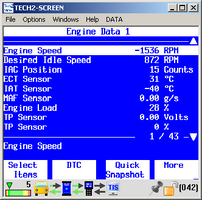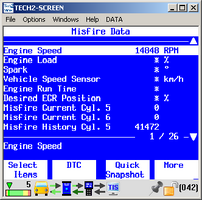AmpOverload
Member
OK, the fuel level PID that works on my 2007 Envoy SLE is:
PID 12
unit: %
equation: A/2.55
header: A982F1
The value sems pretty accurate although sometimes it jumps to a very different value then back to the proper value(don't know why).
I'm actually very curious of this myself. I can answer half of this question about half of the data, but as a result I have a second question.I have to ask.... Where did you discover this PID setup?? Was it here somewhere or on another website?? Did you study up and create it yourself??
The reason I ask this is that while this works with Torque Pro other apps will likely not work with this setup. This is because this is not a true PID (parameter ID) but instead taps into the normal serial data communications between modules and most apps are not programmed to do this.
I believe A9 is a priority 5 (range: 0-7) Functional Request/Query. 82 is the Target byte and F1 is the diagnostic test tool and is the Source byte.
I don't know where the A9 header byte comes from or what it does, but now I want to.
The 82 header byte is fuel system status command.
I don't know where the F1 header byte comes from or what it does either, but now I want to.
@azswiss & @TJBaker57 nicely explained the meaning of the bytes, so all I have to add is an answer to "Thoughts on [...] why the bytes are out of sequence?". This is just how SAE J1850 functionally addressed messages work, as opposed to physically addressed messages (like Mode $22 PID commands to query vehicle data). With functional addressing under SAE J1850, the 3 OBD message header bytes (specified to an ELM327-compatible scantool with a single 'ATSH xx yy zz' command) use the 'yy' position to specify the so-called "Primary ID" ($82 "Fuel System" in our example) of the commands to follow. Then, each command sent to the scantool after that (until the OBD message header changes with another "ATSH xx yy zz" command) contains the so-called "Secondary ID" ($12 "Fuel Level - Percent" in our example). That's actually slightly over-simplified, because there are other things in functional addressing (like so-called "extended" addresses) but this is covered by SAE J2178-4.I'm actually very curious of this myself. I can answer half of this question about half of the data, but as a result I have a second question.
[...]
Thoughts on what A9 and F1 mean and why the bytes are out of sequence?
Sorry TJ, I've been busy with life and didn't get back to this thread until now. Sadly I don't remember where I found that PID setup. I have the excel sheet of yours and tried various things from there but I may have tried other sites until I found this seems to work. It's September 29th now so this thread has moved ahead, I know.I have to ask.... Where did you discover this PID setup?? Was it here somewhere or on another website?? Did you study up and create it yourself??
The reason I ask this is that while this works with Torque Pro other apps will likely not work with this setup. This is because this is not a true PID (parameter ID) but instead taps into the normal serial data communications between modules and most apps are not programmed to do this.
Now then, we could possibly use that same approach to look into your TPMS issue. If the Trailblazer class vehicles use the same approach as my 2005 Yukon there will be a module that receives the radio signals from the tire sensors and then continuously broadcasts the data on the serial data bus where the cluster picks it up and does it's job if displaying said data. Using a serial terminal app and the same dongle that is used with the Torque app these data messages can be monitored and within these messages we can see what module is sending them and are all wheels represented or is one or more missing and so on.
On my Yukon the module responsible for TPMS is the passenger door module. I haven't had the opportunity to check a later model Trailblazer class vehicle so while I might guess it's the same module I cannot say that it is.
SAE standard Mode $01 PID $11 ("Absolute Throttle Position") is A/255*100 percent. I always see some noise (up to about 0.4 percent) in that value when it should be zero, so 3 percent sounds a little high to me. Others here will probably have more relevant answers though, since I typically test on GM cars, not trucks.Good evening everyone.
Drive by cable on my 2002 LM7. Can someone confirm the formula for the TPS position PID? My Torque app sometimes shows zero any other times shows 3 at idle and key on/eng off both hot and cold. I would think if the throttle blade is closing completely it should read zero but if the formula was wrong it would read wrong all the time. WOT shows 100 so the formula can not be to far off. It might just need a good cleaning but wanted to make sure I was not running down a rabbit hole.
Nothing to add from me, really. Three percent isn't alarmingly high, so if there were no obvious issues related to erroneous TPS reporting and if the live, monitored value of TPS is smooth (no large spikes, etc) as you move the pedal from 0 to WOT (and back to 0), then I'd just do what you're planning along with some pre- and post-cleaning monitoring of that value. And please let us know how it goes.Thank you. I think it is high as well but it does not make sense to me that it reads zero sometimes and 3 at others. Any ideas on that?
| Long Name | Short Name | Mode&PID | Formula |
| [GM]Misfire Cyl.1 Current | MF C1 Cur | 221205 | A |
| [GM]Misfire Cyl.2 Current | MF C2 Cur | 221206 | A |
| [GM]Misfire Cyl.3 Current | MF C3 Cur | 221207 | A |
| [GM]Misfire Cyl.4 Current | MF C4 Cur | 221208 | A |
| [GM]Misfire Cyl.5 Current | MF C5 Cur | 2211EA | A |
| [GM]Misfire Cyl.6 Current | MF C6 Cur | 2211EB | A |
| [GM]Misfire Cyl.7 Current | MF C7 Cur | 2211EC | A |
| [GM]Misfire Cyl.8 Current | MF C8 Cur | 2211ED | A |
| [GM]Misfire Cyl.9 Current | MF C9 Cur | 2211EE | A |
| [GM]Misfire Cyl.10 Current | MF C10 Cur | 2211EF | A |
| [GM]Misfire Cyl.11 Current | MF C11 Cur | 2211F0 | A |
| [GM]Misfire Cyl.12 Current | MF C12 Cur | 2211F1 | A |
Many thanks, @azswiss!CSV extracted from Torque Pro below.
Agree. I've gotten used to it, though.Curious that the Mode/PID numbering is not sequential.


The next time I perform a repair on that Century (which is not my vehicle), I may take the opportunity to induce a misfire on a specific cylinder to confirm, without a doubt, just which PID is associated with which cylinder, removing even the possibility mentioned in the previous paragraph.
OK, good! If your 2002 TrailBlazer is really a P10 PCM as I think, then that seems to confirm my earlier statement that it is not affected.I just now used a Tech 2 and the "cylinder balance test" which selectively disables a single cylinder one at a time. This was done on my own 2002 4.2 LL8.
Reviewing the data log reveals "cylinder 1" as selected by the Tech 2 during said balance test to be reported at PID 1205. Cylinder 2 is at 1206 and so on. There were insufficient misfires to generate a history value so I cannot comment there.
I'm not certain what the best way to induce a misfire in a specific cylinder might be. I was considering simply removing a single cylinder's plug wire for a short duration but I'm always hesitant to experiment on a vehicle that's not mine.I guess that be absolutely certain I could manually disable cylinder 1 by some means right at the coil like setup a test where I can physically remove the control signal or something similar?
Based on my 2005 Avalanche test, I'm suspecting that you'll find that it is affected. Waiting with 'bated breath....Next up I will have a look at my 2005 Yukon with 5.3 LM7.

The other problem I have is not always knowing which "Product Line(s)" to select in Tech2Win. I chose "C" for the 2005 Avalanche (EDIT: even though the VIN has 'E' at that spot, which was not available in Tech2Win) because it had the 5.3-liter V8 "L59" engine option. What do you choose for your 2005 Yukon?
Thanks! I think I figured out my problem. GM uses VIN character #4 for "platform" on the Buicks (and maybe on all passenger cars) but it appears that they might use VIN character #5 for that same info on trucks! The 2005 Avalanche had a "K" at position 5.For my Yukon I choose "K" and then later of course the 5.3 LM7 that I have.
I need to play with that option a bit. I don't think I've tried it since I got my VCX Nano last week.Unfortunately the Yukon cylinder balance test does not display misfire counts! Odd.
I know why I missed #123 (before my time) but I have no idea how I missed #546! Thanks for the extra info!I can confirm that the misfire history PID swap is also true on my 2002 LM7. This subject refers back to post #546 and from as far back as post #123. I had actual misfires on cylinder 1 & 2 and watched as the counts on each transferred from current to history confirming the issue.
Now I'm even more intrigued. The plot thickens....To add from my testing, I believe it is not the “current“ PID‘s are swapped but the history. I have monitored and troubleshooted this by removing the plug wire from each cylinder separately and watched side by side current on the left and history on the right to verify. It also proved out that that the only cylinders effected by this is 1 & 2.
Good question. I wish I knew the answer. I'm still searching for that webpage that I know is saved on my system... somewhere.Now I am intrigued as well! How do I verify which PCM my LM7 is running?

Actually, I think you're clearing the waters. Unless I've missed something, everything you've tested matched my predictions and even ruled out the "longshot" possibility that GM's PCM code was wrong.Well I will further muddy the waters here. I just pulled harness wires on my 2005 5.3 LM7. Cylinder 1 first then cylinder 2 second. My current counts were swapped but my history counts were true.
Cylinder 1 current = 1206
Cylinder 2 current = 1205
Cylinder 1 History = 1201
Cylinder 2 History = 1202
My Tech 2 displayed the results properly.

The only thing that confuses me now is @Enroute's suggestion that it's the "history" counts whose PIDs are swapped in the Torque definitions and not the "current" counts. And when I read his post #125 it seems to be saying the opposite of that.
Very true. I also have a hardware vehicle simulator that is turning out to be far more useful than I ever envisioned when I was designing it!We have the advantage of seeing the data packet creation details that at the least suggest the PIDs vary between platforms/ECM/PCM.

Indeed. BTW, many thanks for doing those tests! I won't have access to any GM vehicles for several days, unfortunately.That, coupled with my test where I physically disconnected a coil while recording the PID values proves at least in the case of my 2005 P59/LM7 combo that cylinder 1 current misfires are reported at PID 1206 and #2 at 1205.
Agreed. That's what I was essentially pointing out in the middle part of my post #576 above.Just watching current and history counts per cylinder on an engine that has multiple misfires occuring cannot prove which PID(s), current or history, could be switched. Only a controlled test can do that.
I suspect the latter. If true, however, it makes me wonder why the P10 PCM uses sensible PID assignments but the later P12 PCM seemingly goes back to the oddball "swapped" assignments!I cannot help but wonder if this was purposefully programmed like this in the PCM, or an error that was simply adjusted for later in the scantool programming.
Great reference, thanks @AmpOverload!BTW, I forgot to mention the website with that "what GM PCMs are used on what vehicles" data whose saved page I finally found on my PC. So, in case anyone else finds it useful:
https://www.pcmperformance.com/programming.html
Thanks for clarifying. No problem on the confusion factor. I think it's reasonably well sorted now.so it does seem that it is the ”current” PID’s that are swapped And my reference from my post #125 does state the issue correctly. Sorry for adding confusion to this topic over and above the confusion that the predefined PID list seems to define them incorrectly.
I suppose it depends on what you mean by "version".Do you guys seem to think that this swap could be PCM version dependent?
the predefined PID list seems to define them incorrectly
So true. But somewhat comically (IMHO), assuming PCM families behave similarly, Torque Pro would probably be correct far more often on those 2 PIDs if that GM add-on list swapped the cylinder #1 & #2 "current misfire" PIDs!For some vehicles the predefined list is correct as far as misfire PIDs go.
Irrelevant side issue: That reminds me of something I saw yesterday during my testing....There are errors elsewhere in there, such as the equation for "shift error"s. They don't handle negative values as they should.


A/256*0.9 voltsA/230.4 volts(0.434*A)*10 millivoltsA/230.4147465 voltsA/256*0.9 voltsA/230.4 volts(A*.005)-0.068 voltsA/200 volts
